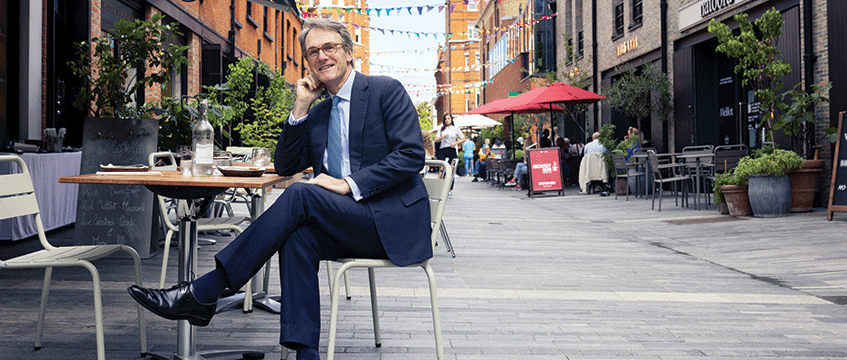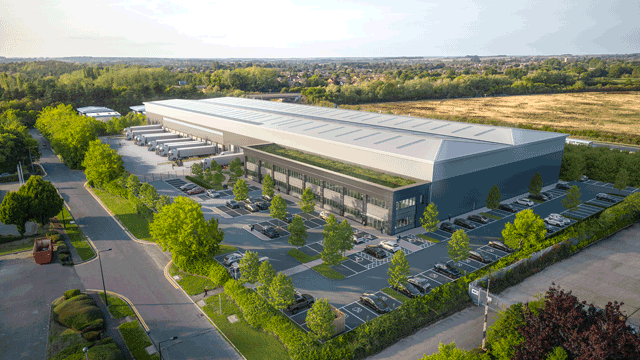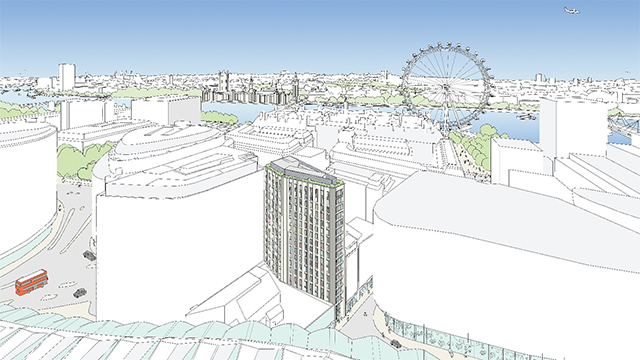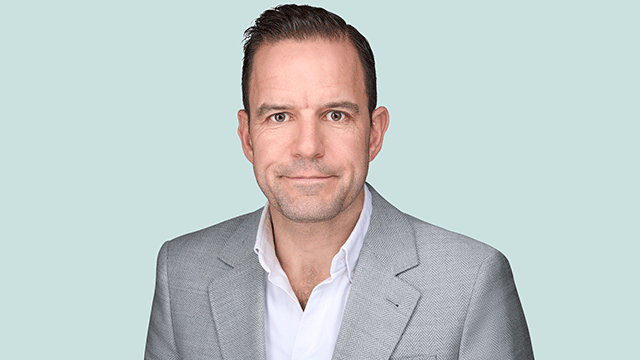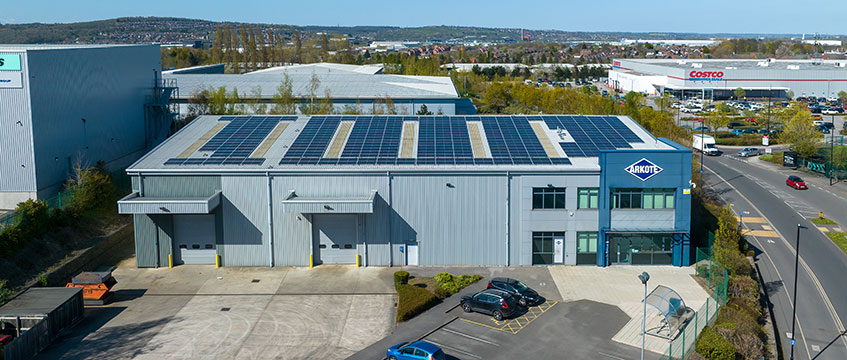Hugh Seaborn has left the bike at home today, across the river in Wandsworth. “The mildest tailwind and I’m an absolute hero,” the chief executive of the Cadogan Estate says. “The mildest headwind and I’m a bleating lamb.” He laughs. “Must be a characteristic of mine.”
If headwinds truly were a problem for Seaborn, he probably wouldn’t spend so much time sailing. The 59-year-old has just come back from a jaunt around Chichester harbour with two of his three sons, testing the limits of his “steady Cornish fishing boat”. “The winds were so strong that I worried I was being a little reckless,” he says. “I wasn’t being a very responsible father at that point.”
But that is nothing compared to the headwinds facing him in his business life. In June, the Cadogan Estate published its annual accounts. More than £800m had been knocked off the value of the Chelsea estate as Covid added to existing pressures. Retail values dropped by a quarter. Dividends were cut by 70%. Nonetheless, Seaborn is upbeat. Challenging though they may be, such issues are short-term problems with long-term solutions. And Seaborn rarely thinks short term.
Besides, there are bigger challenges to come. In June, Cadogan also published a pledge. By 2030 it wants to be a paragon of sustainability and net zero for carbon emissions. It is far from the only property company to make such a pledge. What is striking, though, is just how difficult the target will be for Cadogan to achieve.
A patch of London
Cadogan is one of London’s few remaining “great estates”, along with Grosvenor, Portman, Howard de Walden and the Crown. In a way they are relics of a bygone age, the last survivors of a time when London was owned by aristocratic families, pieced together over generations through a combination of ruthless acquisition, high-risk speculative development and opportunistic marriages.
This is the challenge facing Seaborn. “We have a big portfolio and it is granular,” he says. As well as 3,000 homes, the 93-acre estate has 500,000 sq ft of office space, 300 shops, nine hotels, seven schools and a dozen pubs. “That granularity makes it complex.”
But Seaborn is confident that the 2030 target can be achieved. He points to 126 Pavilion Road, SW1. The 19th-century mews house is the sort of place where 1960s models and rock stars would have held after-after-after parties. In 2018, Cadogan attempted an experiment.
“We wanted to see if we could bring it up to PassivHaus [energy performance] standard,” Seaborn says. It did. Despite the building being listed and originally constructed as a stable, the team was able to reduce energy consumption by 85%. It is now one of just 250 properties in the UK that meet the standard, and one of the oldest buildings in the UK to achieve a BREEAM Outstanding rating. Despite the headwinds, that house is in the top 1% of energy efficient buildings in the UK.
And yet the task ahead is not as simple as replicating that across the wider estate. “We could do a couple of dozen PassivHauses,” Seaborn says. “But we want to make the most impact we can.” Instead, the estate is dramatically improving every residence it can when the tenants move out, nudging each one up the EPC ratings, and doing the same with its commercial estate.
Wouldn’t Seaborn prefer to be running something a little less complex, especially now that it has to be retrofitted to meet new targets? “If we had a commercial portfolio of a couple of score of buildings, yes, of course, it would be easier,” he says. “They would be bigger scale. Let’s say they would be more modern, with higher building standards and so on.”
Seaborn knows the difference well. He joined Cadogan as chief executive in 2008, replacing Stuart Corbyn. Prior to that he was at the helm of the Portman Estate for nine years. Aside for some shared core values, the estates are “very different,” he adds. Portman is almost entirely offices, while Cadogan is an overgrown high street in terms of its mix.
The forthcoming Waitrose development, part of Cadogan’s £500m development programme, will have nine uses on one site. “It’s not how anyone would put together as a portfolio, because it isn’t a portfolio. It is a patch of London,” Seaborn says.
Collaboration and partnership
The variety works, Seaborn says. “It’s holistic. The retail contributes to the character of the area, which contributes to the attractiveness of the residential. The offices are important to us because they bring different customers, different footfall, different pedestrian activity at different times of the day, and that creates more vitality.”
Traditionally, the estate was largely residential with a few shops. But since the enfranchisements started in the 1980s, that has been changing. “We are now a hospitality estate with some residential,” Seaborn says.
About five years ago, the proportion of residential went below 50% for the first time. Now it’s about a third of the estate. Retail, by contrast, now accounts for around 44% by value – at £2.1bn – but more than half of all income.
Cadogan already has green leases for all retail tenants, but it is now going a step further. Seaborn highlights fit-outs like that of women’s fashion brand Ganni, which is 100% recycled and recyclable. Seaborn says he is also learning a lot from Balenciaga and the Kering Group.
This co-operative approach, “collaboration and partnership”, is a strong theme for Seaborn.
He recalls the early days of the pandemic, when Cadogan offered 100% relief to its commercial tenants and happily switched to turnover rents. “They are the lifeblood. You have to look after them. We wanted to,” he says. Now the restaurants and streets are busy once again – partly due to the alfresco seating that Cadogan quickly set up.
In addition to the challenges of retrofitting the old estate to meet modern environmental standards, Cadogan has a £500m development pipeline. Around two-thirds of Cadogan’s carbon usage comes from construction, and the estate is trying everything it can to improve its impact there, from heating systems to making specific requirements of construction partners.
“We are experimenting with it,” Seaborn says. “That’s what the 2030 strategy is there to do really.” A clear target and a big ambition? “As long as we are ambitious about what we are trying to achieve, that will push us. That will make us try things and test things and see what’s effective.”
And what if that target can’t be met? “The answer is we will have to offset to a greater extent. And that’s very expensive,” he adds. “So we have a business interest and a business priority in reducing our carbon footprint as much as possible.”
Seaborn is also keen to anticipate any regulatory changes that might be on the horizon. “Part of the business justification for doing this is that it is coming anyway.” The smart thing to do is to get ahead of the change and do it in a way that is manageable and strategic, “rather than it being imposed on you with three months’ notice”.
Collective endeavour
The point is simply for Cadogan to play its part. “Alone, we are not going to change anything. We are not even a pinprick,” Seaborn says. But by being seen to do the right thing, he hopes the estate will inspire others to as well, no matter how hard it may be. ”It is about being part of a collective endeavour,” he states.
Some have estimated the cost of the 2030 vision as at least £70m. However, it isn’t a figure that Seaborn is willing to confirm or deny.
“We have an idea of what we think the figure might be, but it isn’t one I have confidence in. That’s why we have a strategy. We are going to be transparent about it, but there is no sense in putting a figure on it now because we don’t know. We haven’t done this before, so we don’t know how we are going to progress.”
What he is certain of, though, is that any cost would be dwarfed by the alternative. “The cost of not doing this, I couldn’t start to tell you. But I know it is enormous. We all know it is enormous. There is no way that this isn’t a good investment.”
Cadogan has appointed a new sustainability head, Kate O’Neill. But she isn’t the only one keeping Seaborn’s compass pointing in the right direction. “I’ve got 17, 16, and 13-year-old sons and they are also my sustainability manager, really,” he laughs. “And you know that they are brutal about it.”
And behind that joke, the long-termism, the sense of a responsibility to a future generation, is again apparent. “And it is not virtuous. It is just necessary.”
Seaborn is squeezing in one more break before the summer is completely over. Perhaps he will go sailing again?
“You know, I learnt to sail when I was growing up in east Yorkshire, “ he recalls. “A friend and I used to go out in wellies and mackintoshes by Filey Beach. It was so inhospitable I wonder why I ever kept doing it.”
Because, whatever he may say, Seaborn is tenacious. And nothing makes him work harder than a strong headwind.
To send feedback, e-mail piers.wehner@eg.co.uk or tweet @PiersWehner or @EGPropertyNews







